2014 Lion House.
All rights reserved. No part of this book may be reproduced in any form or by any means without permission in writing from the publisher, Deseret Book Company (permissions@deseretbook.com), P.O. Box 30178, Salt Lake City Utah 84130. This work is not an official publication of The Church of Jesus Christ of Latter-day Saints. The views expressed herein are the responsibility of the author and do not necessarily represent the position of the Church or of Deseret Book. paper)
1. paper)
1.
Mormon cooking. 2. The Church of Jesus Christ of Latter-day SaintsPresidents. 3. Lion House (Restaurant)
TX715.D586626 2014
641.5'66dc232014012921
Printed in China
Global Interprint, Shenzhen, China
10 9 8 7 6 5 4 3 2 1 Much of the material on the prophets printed in this book is drawn from Ann Whiting Allen, Feasting with the Prophets, Deseret News, October 1, 1998. Image credits Robert Casey: pp. v, x, 4, 8, 11, 12, 19, 20, 27, 31, 34, 36, 38, 39, 42, 45, 46, 47, 49, 50, 53, 57, 58, 65, 67, 71, 72, 74, 75, 76, 88, 89, 91, 94, 95, 97, 98, 103, 111, 112
Shutterstock: p. vi
John Luke: pp. viii, 16, 41, 55, 60, 70, 77, 78, 86, 102, 109
Deseret Book Company: p. ix
Jos. A.F. A.F.
Everett: pp. 1, 35, 61. Used courtesy the Lion House
Intellectual Reserve, Inc.: pp. 2 (unknown artist), 5 (Dan A. Weggeland), 6 (A. Westwood), 9 (Lewis A.
Ramsey), 10 (Lewis A. Ramsey), 13 (John W. Clawson), 14 (Lee Green Richards), 17 (Lee Green Richards), 21 (Shauna Clinger), 22 (Knud Edsberg), 25 (Judith Mehr), 26 (Knud Edsberg), 29 (William Whitaker), 30 (Judith Mehr), 37, 43, 44, 48, 51, 52, 56, 114. Prophets portraits used courtesy Church Museum of History and Art
Alvin Gittens: p. 18. 33
Alan Blakely: pp. 59, 63, 66, 69, 73, 81, 82, 85, 101, 104, 107, 110, 113
Temple Square Hospitality: pp. 90, 93
Food stylist Maxine Bramwell: pp. 63, 66, 69, 70, 73, 77, 78, 81, 82, 85, 86, 89, 98, 101, 102, 104, 107, 109 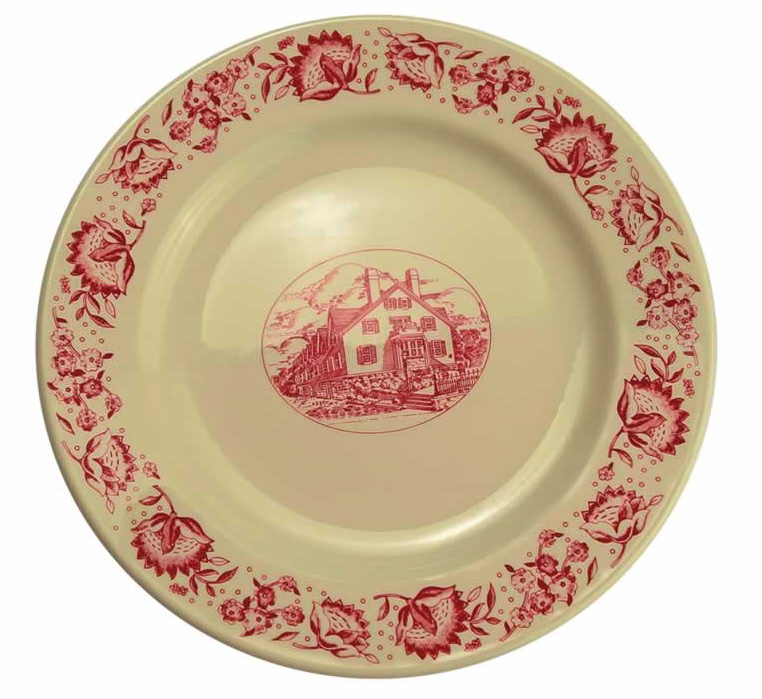 Lion House signature plate. Introduction
Lion House signature plate. Introduction Whether youre huddled around a trailside campfire, being served by white-gloved waiters at an elegant soire, or sitting down at the family table after an exhausting day of service and work, the same time-tested recipesstriking a balance of simplicity and delectabilityhave proven to hit the spot. Introduction
Whether youre huddled around a trailside campfire, being served by white-gloved waiters at an elegant soire, or sitting down at the family table after an exhausting day of service and work, the same time-tested recipesstriking a balance of simplicity and delectabilityhave proven to hit the spot. Introduction Whether youre huddled around a trailside campfire, being served by white-gloved waiters at an elegant soire, or sitting down at the family table after an exhausting day of service and work, the same time-tested recipesstriking a balance of simplicity and delectabilityhave proven to hit the spot.
Whether youre huddled around a trailside campfire, being served by white-gloved waiters at an elegant soire, or sitting down at the family table after an exhausting day of service and work, the same time-tested recipesstriking a balance of simplicity and delectabilityhave proven to hit the spot.
And no place better understands the tradition of serving up dishes sure to comfort and delight than the Lion House. After alltheyve had generations of practice! The Lion House stands proudly to the east of Temple Square in downtown Salt Lake City. Now one of the citys most familiar and enduring landmarks, this fine pioneer home was originally built as a residence for the very large family of Brigham Young, the great Mormon colonizer, territorial governor, and second President of The Church of Jesus Christ of Latter-day Saints. The house gets its name from a stone statue of a reclining lion above the front entrance, the work of William Ward, a skilled English craftsman. The hub of activity in Brigham Youngs day was the street-level floor, which is now home to the Lion House Pantry. This first floor featured a long and expansive dining room, where as many as seventy family members and guests ate.
Other rooms on the floor included large vegetable and fruit cellars; a weaving room, where carpets and cloth were woven; a milk room for storage of milk, cream, butter, and cheese; a laundry room; pantries and cupboards; bathrooms; and a huge kitchen. One corner space served as a schoolroom until a schoolhouse could be completed; then the room was converted into the familys recreation room. Here the children gathered for parties and entertainment. Large steel hooks were attached to the walls for pulling taffy or vinegar candy, and there was a small stove for popping corn. The second floor included several sitting rooms and an elegantly furnished parlor. Here the family gathered for daily prayer and for counsel from the head of the family.
Today the parlor is home to many furnishings and artifacts from Brigham Youngs day, including the bell he used to summon his family to prayer. The third floor of the Lion House originally had twenty bedrooms, ten on each side of a long central hall, with a small fireplace and a dormer window in each room. After Brigham Youngs death in 1877, the Lion House remained in the hands of family members for a short time before it was purchased by the Church. Over the next several decades, the building was used for a variety of social, educational, and cultural purposes. In 1963 the house was closed for extensive remodeling and modernization. After being listed on the National Register of Historic Landmarks in 1964, it was reopened in the fall of 1968 to serve the community as a place to reflect on the culture and heritage of the pioneers who had settled the Salt Lake Valley.
Today, the Lion House welcomes the public to get a taste of the past as they enjoy made-from-scratch dishes from the Pantry or Bakery, gather with friends and family to celebrate special occasions, or imagine the home filled with the sights and sounds of pioneer life. 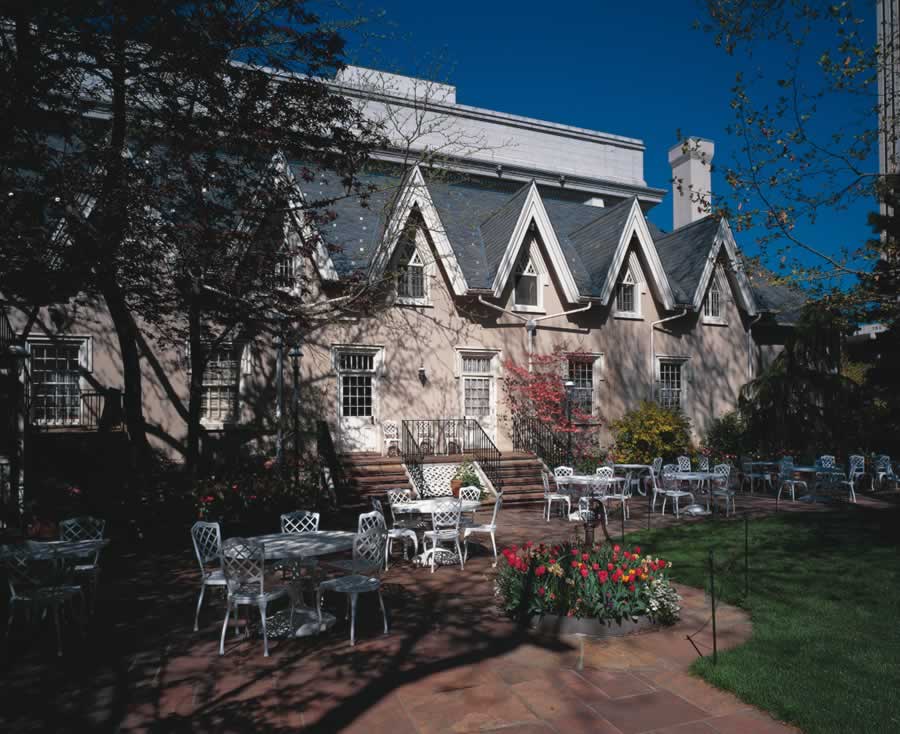 The patio on the east side of the Lion House often serves as a site for wedding receptions. In this latest collection of recipes, the chefs at the Lion House step back in time to re-create favorite dishes enjoyed by the Presidents of the Church through the ages. But one of the most common suppers mentioned in the reminiscences of the Brethren does not appear in these pages. Many have preferred a simple supper of a thick, crusty slab of homemade breadpreferably wheatsaturated with fresh, cold milk. President George Albert Smith was known to graciously decline gourmet entres in favor of bread and milk.
The patio on the east side of the Lion House often serves as a site for wedding receptions. In this latest collection of recipes, the chefs at the Lion House step back in time to re-create favorite dishes enjoyed by the Presidents of the Church through the ages. But one of the most common suppers mentioned in the reminiscences of the Brethren does not appear in these pages. Many have preferred a simple supper of a thick, crusty slab of homemade breadpreferably wheatsaturated with fresh, cold milk. President George Albert Smith was known to graciously decline gourmet entres in favor of bread and milk.
President Spencer W. Kimball even ordered bread and milk while dining at an elegant restaurant in Quito, Ecuador. His wife, Camilla, once told a Church News reporter that suppers of bread and milk were as satisfying to them as a feast. Some prophets have added personal touches to make the dish uniquely their own: President Ezra Taft Benson preferred to garnish his bowl with green onions, while President Harold B. Lee accented his bread and milk with cheesethe sharper the better. President Wilford Woodruff related in his journals that crumbled cheese and green onions were most frequently used, but apple chunks or green grapes sometimes topped the bread for variety.
Of course, Church leaders had to have some favorite foods besides bread and milk. Still, tastes have tended to run on the simple side. Helen Lee Goates, daughter of President Lee, offered an explanation for the popularity of the humble supper: Few people understood the rigorous schedule the prophets maintained. At the end of a strenuous day of meetings or after arriving home late from a travel schedule, food had to be simple and quick. During conference visits, the wonderful sisters of the Church fed the General Authorities the richest and tastiest recipes. Bread and milk was a quick yet refreshing contrast.

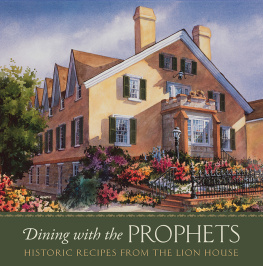
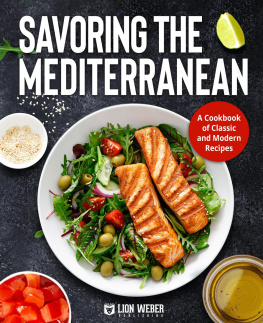






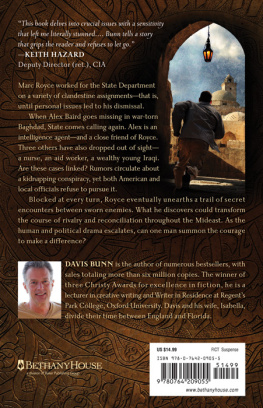


 Lion House signature plate. Introduction
Lion House signature plate. Introduction Whether youre huddled around a trailside campfire, being served by white-gloved waiters at an elegant soire, or sitting down at the family table after an exhausting day of service and work, the same time-tested recipesstriking a balance of simplicity and delectabilityhave proven to hit the spot. Introduction
Whether youre huddled around a trailside campfire, being served by white-gloved waiters at an elegant soire, or sitting down at the family table after an exhausting day of service and work, the same time-tested recipesstriking a balance of simplicity and delectabilityhave proven to hit the spot. Introduction The patio on the east side of the Lion House often serves as a site for wedding receptions. In this latest collection of recipes, the chefs at the Lion House step back in time to re-create favorite dishes enjoyed by the Presidents of the Church through the ages. But one of the most common suppers mentioned in the reminiscences of the Brethren does not appear in these pages. Many have preferred a simple supper of a thick, crusty slab of homemade breadpreferably wheatsaturated with fresh, cold milk. President George Albert Smith was known to graciously decline gourmet entres in favor of bread and milk.
The patio on the east side of the Lion House often serves as a site for wedding receptions. In this latest collection of recipes, the chefs at the Lion House step back in time to re-create favorite dishes enjoyed by the Presidents of the Church through the ages. But one of the most common suppers mentioned in the reminiscences of the Brethren does not appear in these pages. Many have preferred a simple supper of a thick, crusty slab of homemade breadpreferably wheatsaturated with fresh, cold milk. President George Albert Smith was known to graciously decline gourmet entres in favor of bread and milk.